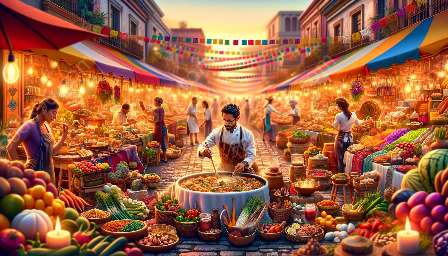Latin American cuisine is a vibrant tapestry woven together by a rich history of cultural exchange, with European colonization playing a significant role in shaping the culinary traditions of the region. The fusion of indigenous ingredients and cooking techniques with those introduced by European colonizers has created a diverse and flavorful culinary landscape that is celebrated worldwide.
European Colonization: Shaping Latin American Cuisine
The arrival of European settlers in the Americas brought about a momentous exchange of foods, cooking methods, and culinary traditions. The impact of this colonization on Latin American cuisine can be observed in various aspects, including:
- Ingredients: European colonization introduced a wide array of ingredients to the Americas, such as wheat, rice, sugarcane, citrus fruits, and various herbs and spices. These new ingredients were integrated with native American staples like corn, potatoes, tomatoes, and beans, resulting in the development of unique flavor profiles and dishes.
- Cooking Techniques: European cooking techniques, such as baking, frying, and roasting, were combined with indigenous methods like steaming, grilling, and using traditional earthenware pots. This fusion of cooking techniques gave rise to a diverse range of cooking styles and preparations.
- Culinary Traditions: European colonization also influenced the establishment of social and cultural dining practices in Latin America. Influences from Spanish, Portuguese, French, and other European cuisines contributed to the development of festive dishes, communal eating traditions, and a vibrant culinary heritage.
Spanish Influence on Latin American Cuisine
The Spanish colonization of Latin America had a profound impact on the culinary landscape of the region. Spanish cuisine introduced new ingredients such as wheat, olive oil, and various spices, which were integrated with indigenous foods to create iconic dishes like tamales, empanadas, and ceviche. Additionally, Spanish culinary techniques like sautéing and braising influenced the preparation of traditional Latin American dishes, adding depth and complexity to the local gastronomy.
Portuguese Influence on Latin American Cuisine
Portuguese colonization also left an indelible mark on Latin American cuisine. The introduction of ingredients like cassava, cashews, and coconut significantly impacted the culinary repertoire of Latin American nations with Portuguese heritage. The fusion of Portuguese flavors with indigenous cooking methods gave rise to delectable dishes such as moqueca (a Brazilian fish stew), acarajé (fried bean fritters), and feijoada (a hearty bean and meat stew).
French Influence on Latin American Cuisine
French culinary influence permeated certain regions of Latin America, particularly in countries such as Haiti and parts of the Caribbean. French techniques in baking, pastry-making, and sauce preparation were integrated with local ingredients to create unique dishes like pain patate (a sweet potato pudding) and bouillon (a hearty soup). The fusion of French and indigenous culinary traditions resulted in a captivating blend of flavors and textures.
Modern Impact and Evolution
The influence of European colonization on Latin American cuisine continues to evolve, with modern interpretations and culinary innovations shaping the gastronomic landscape. The legacy of European ingredients and cooking methods in Latin American cuisine serves as a testament to the enduring impact of historical events on culinary traditions.
Today, Latin American cuisine stands as a testament to the enduring influence of European colonization, with a fusion of flavors, ingredients, and techniques that showcase the richness and diversity of the region's culinary heritage.

